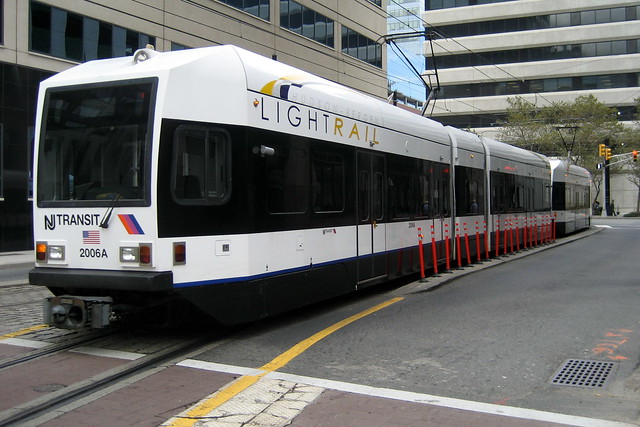Hudson-Bergen Light Rail line in Jersey City, NJ. Photo (cc) Wally Gobetz.
Streetsblog: Why Free Black Friday Parking Is a Bad Idea
Lastly, providing free parking creates an inequity issue for people who do not own a car. As I’ve noted before, more than one-quarter of Cleveland households lack access to a vehicle. Yet, because the cost of parking is already factored into the price of retail goods, these individuals will have to pay for the hidden cost of parking, despite the fact that they will not take advantage of it. Ohio’s transportation policies are already skewed heavily enough towards driving. The round-trip cost of taking public transportation to Tower City ($4.50 per person) is higher than the price for two hours of on-street parking. Requiring the City to pick up this tab only serves to widen the gap between drivers and non-drivers.
The Atlantic Cities: Why Correcting Misperceptions About Mass Transit May Be More Important Than Improving Service
If you want to understand why people use a certain transit system, it makes sense to start with the system itself. Frequency, access, and any other service qualities that make riding as convenient as driving will help. Whether or not the way a city is designed and built nudges people toward the system — via residential density and street design, for instance — matters, too.
But as we’ve pointed out in the past, there’s a psychological component to riding transit that’s easy for city officials and planners to overlook. Fact is, we’re not all completely rational about our travel decisions. The perceptions that people have about public transportation, substantiated or not, are powerful enough to attract or repel them.
Governing: New Pennsylvania Law Will Increase Transportation Funding by Billions
Pennsylvania Gov. Tom Corbett signed legislation Monday that will eventually provide an additional $2.3 billion annually for infrastructure.
The legislation scraps the state’s 12-cent gas tax and lifts a cap on the wholesale taxes of fuel. Those taxes would then be passed on to consumers. The tweak would reportedly translate to a 28 cent-per-gallon increase on gas taxes for drivers, up from the current 32.2 cents.
The Keystone State now joins a slew of others that have enacted major boosts in infrastructure funds, in part due to a stagnant federal funding for transportation.
WPRI: RIDOT could lose $199m in federal money
The director of the Rhode Island Department of Transportation, Michael Lewis, told a breakfast crowd Thursday that the state might not be able to start any new highway or bridge projects a year from now. The source of the money, a federal trust fund financed with the federal gasoline tax, is going broke.
ecoRI: Providence Works to Define ‘Sustainability’
What does “sustainability” mean? What does this word mean to a city split by I-95, having its West Side defined by low-income, varying racial demographics, and its neighborhoods perceived to be filled with crime and wastefulness, and its East Side defined by academia and the Ivy League, and its neighborhoods viewed to be high-end living with low crime?
Depending upon where you live, what you do for work and/or your role within the community, the word “sustainability” can hold all kinds of meaning, depending on various economic, social economic and environmental impacts.
Governing: Cities Set Their Eyes on Light Rail
Tucson has built four-mile-long streetcar tracks that will run between the University of Arizona campus and downtown. Only two of the eight cars that will be used to ferry passengers every 10 minutes have arrived, and operations will not start until next year.
But local business leaders say the streetcar has already revived the center of this sprawling, artsy city of 524,000. Roughly 150 businesses have opened their doors along the route in the last five years, and the once-dormant area is in the middle of a $230 million construction boom, according to the Downtown Tucson Partnership. The group estimates that 2,000 jobs have been created or relocated to the area.






See that NJ Transit light rail? That’s what should be running in RI connecting Providence to Cranston, Warwick, Pawtucket, etc.
But we can’t even get a streetcar line built in Providence. It’s pitiful.
Also include Central Falls. What would be the route?
Though it’s more linear, the density and population of Hudson County is similar to the Providence core cities (CF, Pawtucket, NP, Providence, Eastern Cranston, East Providence).
New Jersey’s Hudson Bergen Light Rail (HBLR) wasn’t cheap. Initial phase construction costs were $992M. The tab for the current 24-station, 21-mile system is roughly $2.2B.
HBLR had an advantage that Providence doesn’t, which is that aside from the Jersey City three-quarter mile long segment that runs in streets like a streetcar, most of the route is located in abandoned or underutilized freight RR right-of-ways.
For Providence, if a light rail system ran along city streets, speeds would be about the same as the current bus system. Amtrak controls Providence’s primary RR right-of-way.
Bus – #99 from KP to Downtown Pawtucket takes a little over 25-minutes.
Train – from Providence Station to Dexter Street in Pawtucket would take about 8-minutes.
Bus – from Olneyville Square to Hunt Street, Central Falls, not including transfer wait time, would take about 50-minutes.
Train – Olneyville Square to Hunt Street would take roughly 12-minutes.
With a hefty price tag for light rail and comparable costs to increase capacity on heavy rail, which system would produce the greatest benefit to the Providence area?
Lots more people will use 10 -25 minute rides among dozens of stops that see a streetcar every few minutes than will use 5 – 8 minute rides among 2 or 3 stations with half hourly service.
If segregated street ROW plus signal priority can be implemented in and near downtown where it is most needed (instead of only where it can be done with zero impact on driving and parking) 5 minutes could be saved from each trip.
Why would a train have to be limited to only once an hour and why would a Rhode Island line only have to have three stops? There’s no reason why a train serving the internal Providence market needs to be double-decker 8-car long train sets. As little as two single-deck cars would likely be enough to serve the Providence market.
Recently it’s been mentioned that articulated buses may be used on the R-line rapid bus, since presently on the 11 and 99 people are often being passed by at stops due to significant overcrowding.
Instead of proposing to reproduce roughly the same travel times in the same right-of-ways using light-rail, it might be worth seeing if the enhancements on the R-line along with new articulated vehicles and the few dozen proposed stations, which are generally at subway station distances, will work at attracting new passengers ahead of plunging $1- or $2-billion into a new system.
The proposed Providence Streetcar would work as a downtown circulator, but so would a bus at the same schedule. The difference is without rail, job creation and real estate development generally doesn’t follow.
There are a few abandoned or underutilized RR right-of-ways as well as a few wide streets, where limited access right-of-way could be developed for light-rail, but theres’s never been a study to figure out where or what the routes or destinations would be.
Speed matters.
Why I suggested the train instead of light-rail is that a lot of investment has gone into commuter rail, which is floundering. Proposing light-rail without any study, won’t help the investment already made commuter rail and investing in another system without significant study could produce another flopping fish.
Both Streetcar/Light-rail and a Commuter Rail shuttle need to be studied. The problem is that currently there’s little political will or stomach for more than automotive transportation.
Downtown, Olneyville and maybe Adelaide are the only prospective walkable station locations along the main rail line in Providence. Plus the one in Pawtucket/CF. That is why I said 3 stations.
Commuter rail works in metro areas where there is a huge concentration of jobs downtown and rush hour traffic makes taking a train faster than driving. Neither condition applies here. Commuting by car in the Providence area is really easy! I do not need a study to tell me that transit infrastructure built in hope of coaxing suburban commuters out of their cars is a waste.